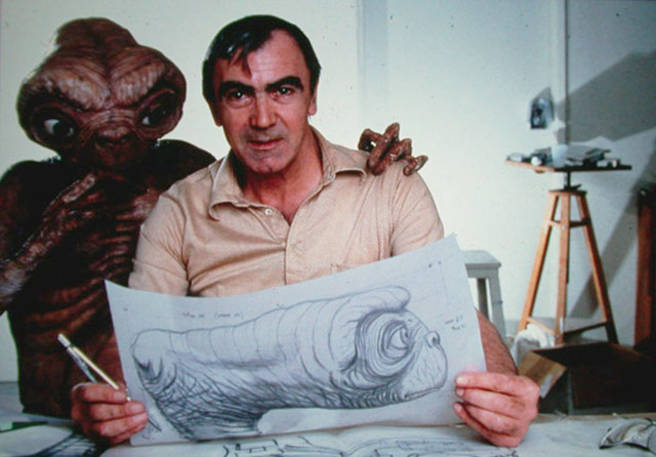


All American news outlets reporting on his death call him a special effects master yet there are many more ways to describe him. Some have simply written “Father of E.T. Dies.”
“Carlo Rambaldi was E.T.’s Geppetto,” said Spielberg, referring to the fictional character who created Pinocchio while Italian director Pupi Avati described him as “a child who loved to play and make his toys. A child who dreams of making a theme park of all his characters.”
Rambaldi, who died at age 86 in his native Italy, was first and foremost an artist and a sculptor. He was born on September 15, 1925 in Vigarano Mainarda, near Ferrara. He attended the Academy of Fine Arts in Bologna [2] where he developed his passion for electromechanics and the anatomy of the human skeleton and musculature. He took his first steps in the world of cinema with a huge dragon created for the film Sigfrido, directed by Giacomo Gentilomo. Never giving up on his dreams of becoming an artist he started working in cinema with renowned Italian directors including Federico Fellini, Pier Paolo Pasolini, Marco Ferreri, Mario Monicelli and Dario Argento (with whom he collaborated on the film Profondo Rosso).
In 1971 he had to prove that his special effects were indeed effects and not not real actions in dog mutilation scenes in the film A Lizard in Woman's Skin. They were so realistic that the film's director, Lucio Fulci, was prosecuted for animal cruelty.
His mastery attracted the attention of Hollywood producer Dino De Laurentiis who brought him to the States to work on John Guillermin’s King Kong in 1976. “In addition to creating masks and other effects Rambaldi’s primary responsibility was to construct a life-size, fully functional mechanical Kong, but his final effort was replaced by a cheaper gorilla suit designed by fellow effects expert Rick Baker. The mechanical Kong can only be glimpsed briefly in the finished film. Rambaldi also designed the two giant ape arms used to hold actress Jessica Lange.”
It was in Hollywood that he developed his skills in mechatronics - a discipline that combines mechanical, electronic and system design engineering to produce special effects, yet he publicly disdained computerized effects.
The Washington Post [3] reports him saying for an interview for La Repubblica “Digital costs around eight times as much as mechatronics. E.T. cost a million dollars and we created it in three months. There are 120 shots. If we wanted to do the same thing with computers, it would take at least 200 people a minimum of five months.”
Ansa reports him saying that with the advent of computer graphics and special effects “the magic is gone, just like when a magician shares his tricks with his audience. Now that anybody can create effects with their home computer something is missing.”
In 1977 he created the spindly extraterrestrials for Steven Spielberg’s Close Encounters of the Third Kind and two years after that he worked on the xenomorph head effects for Ridley Scott’s Alien.In 1982 he re-teamed with Spielberg for E.T. The Extra-Terrestrial [4]. The good-hearted alien became one of the finest effects of his career and most likely his most loved creation. E. T.'s 30year anniversary was celebrated this past June 11th.
He often said that “E.T.'s eyes are those of a cat, as it features the same expression lines of an Himalayan cat.” Reportedly Spielberg always denied that and said instead that E.T. is a mix of Albert Einstein, Ernest Hemingway and Carl Sandburg. Rambaldi spent several months building the sweet alien with the extended neck and the glowing fingertip. He is reported saying “I finished E.T. exactly two days before we started shooting. You can imagine my responsibility in case it didn’t work very well.” But it worked perfectly and the small alien captured the hearts of children and adults alike. E.T. brought him his third Oscar for visual effects, preceded by his work on “Alien” in 1979, and John Guillermin’s “King Kong” in 1976.
Other films he worked on in various effects capacities included Nightwing, Possession, The Hand, David Lynch’s adaptation of the classic sci-fi novel Dune, Conan the Destroyer, the Stephen King-based features Cat’s Eye and Silver Bullet, and King Kong Lives.
“All of us who marveled and wondered at his craft and artistry are deeply saddened by the news of his passing,” Spielberg declared to the Associated Press. But it is not just Hollywood that is going to miss him. Facebook, for example, is filled with remembrance quotes, thoughts from artists of all kinds who were inspired by his craft and his ability to make a gentle animatronic alien seem so hyper-realistic in its features and emotional response that it could make everybody cry, even thirty years later.
Source URL: http://iitaly.org/magazine/focus/art-culture/article/remembering-memorable-carlo-rambaldi-aka-ets-father
Links
[1] http://iitaly.org/files/carlos-rambaldi1344686853jpg
[2] http://www.accademiabelleartibologna.it
[3] http://www.washingtonpost.com/world/europe/italian-special-effects-master-carlo-rambaldi-father-of-et-dead-at-86/2012/08/10/eade6e52-e30e-11e1-89f7-76e23a982d06_story.html
[4] http://www.imdb.com/title/tt0083866